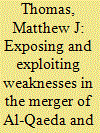| Srl | Item |
| 1 |
ID:
122219


|
|
|
|
|
| Publication |
2013.
|
| Summary/Abstract |
On 9 February 2012 the Somali terrorist organization al-Shabaab officially merged with al-Qaeda. While the significance of the merger is highly contested, it does expose internal weaknesses within the two organizations along ideological, clan, and sectarian lines. The article identifies three key weaknesses of the merger and concludes with a discussion of al-Qaeda's growing presence in trans-Saharan Africa.
|
|
|
|
|
|
|
|
|
|
|
|
|
|
|
|
| 2 |
ID:
122071


|
|
|
|
|
| Publication |
2013.
|
| Summary/Abstract |
The phenomenon of mergers and acquisitions is an ancient one, yet it has gained considerable momentum in recent years. It has also taken root in Israel as local companies utilize mergers as a strategic means for promoting growth and efficiency. The information granted to investors undergoes three main events: rumour of the merger, the declaration of the merger, and its execution. In this article, the merger phenomena in the Israeli market are examined from a different angle. This research attempts to characterize each event using two approaches: in the first, the differences in abnormal returns between the different stages are examined, for both acquiring and target firms. In the second assessment, the dependence of abnormal returns on the number of days between declaration and execution is examined, for both types of firms. The results of the first approach revealed that acquiring companies face negative abnormal returns, while target companies face positive abnormal returns during the days of the events. The second approach exposed a certain investor predilection for different time ranges - i.e. investors favour mergers that are executed in the medium and long term, as opposed to short-term mergers.
|
|
|
|
|
|
|
|
|
|
|
|
|
|
|
|